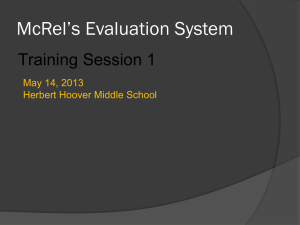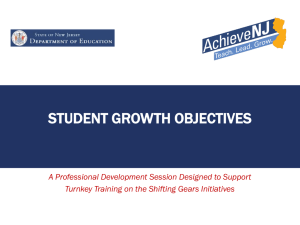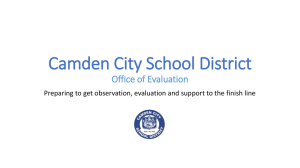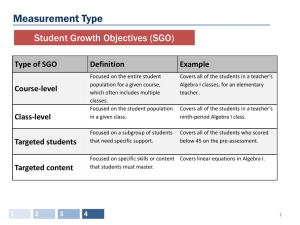PowerPoint SGOs 10-17-14 - Foundation for Educational
advertisement
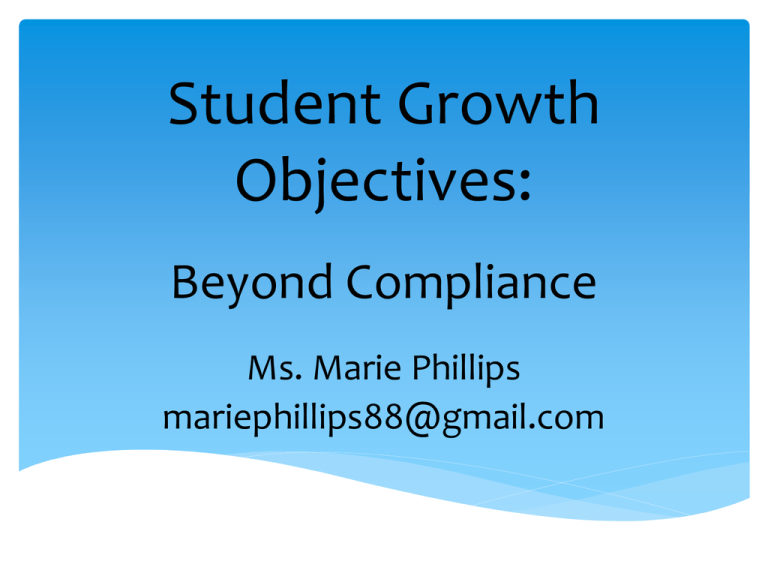
Student Growth Objectives: Beyond Compliance Ms. Marie Phillips mariephillips88@gmail.com Learning Goals WALT use data to inform our instruction and create high quality formative and summative assessments WALT utilize multiple measures to set challenging, yet attainable goals for our students TEST YOUR KNOWLEDGE Test Your Knowledge 2014-2015 1. True or False – SGOs account for 15% of my summative evaluation as a teacher. False Non-SGP teachers; 80% teacher practice, 20% SGO SGP teachers: 70% teacher practice, 20% SGO, 10% mSGP Test Your Knowledge 2014-2015 2. True or False – SGOs must be submitted to my building principal by October 31, 2014. True Test Your Knowledge 2014-2015 3. True or False – SGOs are submitted to NJDOE for approval. False* * Exception - Collecting and reviewing SGOs may be part of the support NJDOE provides to Priority/Focus schools. Test Your Knowledge 2014-2015 4. True or False – Teachers are required to create a pre-assessment whose sole purpose is to determine the starting point for students’ SGOs. False Test Your Knowledge 2014-2015 5. True or False – Teachers may make adjustments to their SGOs. True Test Your Knowledge 2014-2015 6. True or False – SGOs must be aligned to NJ content standards. True* *Exception - Teachers of severely disabled students may set non-academic SGOs. Test Your Knowledge 2014-2015 7. True or False – The building Principal sets the SGO scoring plan that is used by all teachers. False Test Your Knowledge 2014-2015 8. True or False – Teachers may work collaboratively to develop the focus area of a grade/department’s SGO. True Test Your Knowledge 2014-2015 9. True or False – All SGOs must begin in October and end in June. False Test Your Knowledge 2014-2015 10. True or False – Special Education teachers working in an inclusion setting may set the same SGO as their co-teachers. True Student Growth Objectives NJDOE Definition: A long term academic goal that teachers set for groups of students that is: Specific and measurable Aligned to state academic standards Based on student growth and/or achievement Set using available student learning data Developed by a teacher in consultation with his/her supervisor Approved and scored by a teacher’s supervisor www.state.nj.us/education/AchieveNJ GROUP SHARE What did you learn from the SGO process last year? What will you do differently this year? What Has DOE Learned? Reflection of what effective teachers typically do Driven by teachers, supported by administrators and centered on student learning A pre-test as the sole measure of a student’s starting point is not effective Setting the same growth targets for all students results in overly ambitious/overly cautious goals Quality assessments = quality SGOs Common sense should always prevail According to the NJ DOE “There have been no changes in the requirements for SGOs in 2014-15.” http://www.state.nj.us/education/AchieveNJ/teacher/objectives.shtml 2013/14 Update 2014/15 2015/16 55% Classroom Observations 70% 60% Classroom Classroom Observations Observations 30% SGP 10% SGP SGP (Up to 20%) 15% SGO 20% SGO 20% SGO Tested 85% Non Classroom Tested Observations 15% SGO 80% No change Classroom Observations 20% SGO SGOs: What Are They; Really? Not They Are A significant addition to the work of a teacher. A reflection of what effective teachers typically do. According to the NJDOE (2013) SGOs: What Are They; Really? Not They Are An administratordriven compliance exercise. Driven by teachers, supported by administrators, and centered on student learning. According to the NJDOE (2013) SGOs: What Are They; Really? Not SGOs are a statistically precise evaluation of growth based on a pre-test/post-test model of performance. They Are SGOs are learning targets for key concepts and skills that students can be expected to master in a course based on a rough sense of where they start. According to the NJDOE (2013) Five Adjustments for 2014/15 1. SGOs count for 20% of the teacher evaluation. 2. SGO format is modified to reflect the critical components of the SGO process. 3. SGOs should include a significant portion of the courses/subjects, standards, and students for which the teacher is responsible throughout the year. Five Adjustments for 2014/15 4. Educators must explain why the selected standards are critical for the students. 5. SGOs must include a quality assessment process that falls within the framework of the normal testing schedule. The Value of SGOs For Educators… Improves their practice. For Evaluators… Provides an authentic measure of teacher effectiveness. For Students… Improves student learning. Type of SGO Definition General Focused on the teacher’s entire student population for a given course. Includes a large proportion of curriculum standards Specific – Student Group Focused on a subgroup of students that needs specific support. Introducing The 2014/15 Student Growth Objective Form Improving the Process Taking it from… TO… COMPLIANCE Quality The SGO Development Process PREPARE SGO SGO REVIEW and EDUCATOR SGO SCORE STUDENT GROWTH OBJECTIVES PROCESS SCORE SGO RESULTS PRE-APPROVAL STAGE DEVELOP SGO SGO SUBMISSION & APPROVAL IMPLEMENT AND MONITOR SGO EVIDENCE COLLECTION FOCUSED STRATEGIES MID-YEAR SGO REVIEW SGOs are… S M A R T SMART SGOs are… Specific Measurable Attainable/ Ambitious The SGO should The SGO should The SGO should be simplistically be measurable be attainable; written, and and provide reasonably clearly defined. tangible evidence challenging both The SGO should that you have you and your focus on a achieved the students, but specific content objective. clearly defined area or skill. so that it can be achieved. Resultsdriven Timed The SGO should focus on measuring outcomes, not activities. The SGO should be organized around a timeframe that presents a reasonable sense of urgency. STEPS TO CREATING HIGH QUALITY SGOs Identify area of focus Select multiple standards and determine level of significance Choose/Develop Quality Assessments Analyze available student data Set appropriate learning targets for each student Create scoring plan Identifying Your Focus District or Building Goals Areas of deficiency for your student population NJCCCS or Common Core Standards of greatest significance Standards •Select multiple standards. •Align to curriculum. Significance of Standard How much time is spent teaching the standard? Value beyond your grade/course Next grade level/course Other academic areas Life/College/Career Think About This… In Real-Estate it is about… Location Location Location In Education it is about… Assessment Assessment Assessment Choosing / Developing a Quality Assessment: Things to Consider Style What I have now Available resources Time Specific use Depth of Understanding Degree of Challenge HIGH QUALITY ASSESSMENT HIGH QUALITY SGO Assessments Enhance Learning Provide evidence of learning Can motivate learners Signal the need to adjust Assessment Blueprint Prior to test design During test design After test design Approval Checklist Designing Your Assessments Purpose Valid/Accurate Inferences Aligned to Standards Significance of Standard Range of Rigor/Depth of Knowledge Unbiased and Accessible Reliability PURPOSE What information do you want to obtain: Baseline data regarding student’s knowledge? Progress towards an identified goal? Summative data as to achievement of learning goals? Begin with the end in mind Formative vs. Summative Assessment Formative Assessment A process During instruction Carried out by both teachers and students Results used to adjust teaching and learning strategies by both teachers and students Assessment for learning Summative Assessment A single measurement At the end of instruction Designed and conducted by teachers Results used to evaluate student performance by teachers Assessment of learning STOP AND SHARE What types of formative assessments have you used effectively? FORMATIVE ASSESSMENTS • • • • • • • • • • • • Observations Questioning Discussion Journals Assignments Projects Pop Quizzes (not-graded) Exit/Admit Slips Learning/Response Logs Graphic Organizers Peer/Self Assessments Written Questions / Exercises with Short, Extended or multiple-choice Answers • • • • • • • • • • • Practice Presentations Diagnostic Tests Visual Representations Kinesthetic Assessments Individual Whiteboards Four Corners Think Pair Share Appointment Clock Simulations/Business Games Conferencing/Reviews Meaningful Homework Assignments http://wvde.state.wv.us/teach21/ExamplesofFormativeAssessment.html Valid/Accurate Inferences Do the questions provide us valid/accurate evidence about what the student has learned? Are the questions assessing knowledge/mastery of the standard? Valid/Accurate Inference About Learning? SS 6.1.4.D6 Describe the civic leadership qualities and historical contributions of George Washington, Thomas Jefferson, and Benjamin Franklin toward the development of the United States government. You must be a citizen of the United States and _______ years of age to be President of the United States. a) 50 b) 42 c) 30 d) 35 Significance of Standard More Questions/Points Fewer Questions/Points Range of Rigor/DOK NJDOE states a high quality assessment has a range of rigor that: Is representative of the rigor of instructional level and content delivered in the course, and Provides stretch at both ends of ability levels Webb’s Depth of Knowledge Accessibility Clear format and instructions Fair to all students regardless of background Appropriate modifications Example Directions: Write a paragraph based on the writing prompt. Directions: Write a paragraph based on the writing prompt. Describe how the game of soccer is played. Include information about the necessary skills, the rules of the game, and the equipment needed. Describe a game you like to play. Include information about the necessary skills, the rules of the game, and the equipment needed. Reliability Environment conducive to success Consistency in scoring Clear directions and scoring criteria to students Test security Time allotted is sufficient Length of assessment Consistency in results SGO TIP Use skills based rubrics for SGOs. 61 62 TMI Education 64 http://rubistar.4teachers.org/index.php STOP AND SHARE 1. Why is it important to create common assessments? 2. What are some ways to ensure consistency in scoring across grade levels/courses? SGO TIP Do not rely solely on pre and post assessments. Setting Learning Targets Misconception Reality SGOs are a statistically precise measure of growth based on a pretest/post- test model of performance. SGOs are learning targets for key concepts and skills that students can be expected to master in a course based on a rough sense of where they start. http://www.state.nj.us/education/AchieveNJ STOP AND SHARE 1. What are some concerns about using the pre-test/post-test model to assess student learning? 1. In what ways does utilizing only one data source impact the development of high quality learning targets? The Pre-Test/Post-Test Model Extra work for teachers and students that doesn’t result in meaningful student achievement “This doesn’t count” mentality Does not consider other barriers to learning Focuses on one source of data – distorted picture Minimizes importance of what teachers know about their students SGO TIP Ensure that there is a baseline for every student. GROUP SHARE What information is available that may assist you in predicting students’ learning? Possible Information Sources Current/Previous year’s test scores Current year’s formative assessments Standardized test scores over a period of 2-3 years Artifacts from portfolios Attendance records Identified barriers to learning Observations as to learning style and needs Important markers of future success Markers of Future Success http://www.state.nj.us/education/AchieveNJ Sample Target Setting Plan Preparedness Group Prior Year Test Score Current Year Test Score Average Markers of Future Success High 250 - 300 85-100 9-12 Medium 200-249 70-84 5-8 Low <200 <70 0-4 http://www.state.nj.us/education/AchieveNJ http://www.state.nj.us/education/AchieveNJ Creating a Tiered SGO Review multiple data sources available on students Identify patterns to best assign students to groups based on level of preparedness Evaluate and predict growth targets http://www.state.nj.us/education/AchieveNJ SMALL GROUPS OF STUDENTS Use number of students instead of percentages Set goal based on the average score on the assessment for the group – include provision for those who test out of group during year Set individual goals for students especially if wide variety of needs and performance levels Key Components of High Quality SGOs 1. The SGO statement is specific and measurable – what do you expect students to know and be able to do. 2. The scoring plan is consistent with the SGO statement and has a logical four point scale. 3. Growth or achievement targets are differentiated to be ambitious and achievable for all students. Key Components of High Quality SGOs 4. The SGO includes a significant proportion of students and curriculum. 5. The assessment is comprehensive and of good quality. Evidence is provided for standards alignment. 6. More than one data source is used for baseline information. Used thoughtfully to set realistic targets. SGO TIP Utilize the SGO Quality Rating Rubric during the development process. Creating Scoring Bands Represent your predictions as to learning targets for students Established by the teacher with guidance from the Principal to ensure rigor Challenging yet attainable Special consideration for unique situations Sample Scoring Band SGO Statement: 75% of my 6th grade students will achieve their target score on the district’s cumulative science assessment. State the projected scores for each group and what percentage/number of students will meet this target at each attainment level. Modify the table as needed. Preparedness Student Group Target Score Attainment Level in Meeting Student Growth Objective Percentage of Students Achieving Target Score Exceptional 4 Full 3 Partial 2 Insufficient 1 3 70 ≥85% ≥75% ≥65% <65% 2 80 ≥85% ≥75% ≥65% <65% 1 90 ≥85% ≥75% ≥65% <65% http://www.state.nj.us/education/AchieveNJ Weighted Scoring Band Preparedness Group Number Percentage of of Students Students in Each in Each Group Group Weight Assigned to Attainment Score Objective Attainment Level Weighted Score Low 36/65 56% 0.56 3 1.68 Medium 21/65 32% 0.32 4 1.28 High 8/65 12% 0.12 2 0.24 Total Score 3.2 Non-Weighted 3.0 http://www.state.nj.us/education/AchieveNJ SGO “To Do” List September / October Prepare & Develop Identify needs , establish student starting points, and goals for growth. Develop assessments , instructional strategies , and SGO Statement. October Submit & Implement Conference with principal, gain approval by Oct. 31, and begin to implement. October – February Monitoring Monitor the progress of the students. February Mid –Year Review Review and make adjustments as needed by February 15. March / April Scoring & Results Summative assessments administered and SGOs scored. SGO Workshop Feedback Form: Reflect Jot Turn in CONTACT INFORMATION: Ms. Marie Phillips mariephillips88@gmail.com
